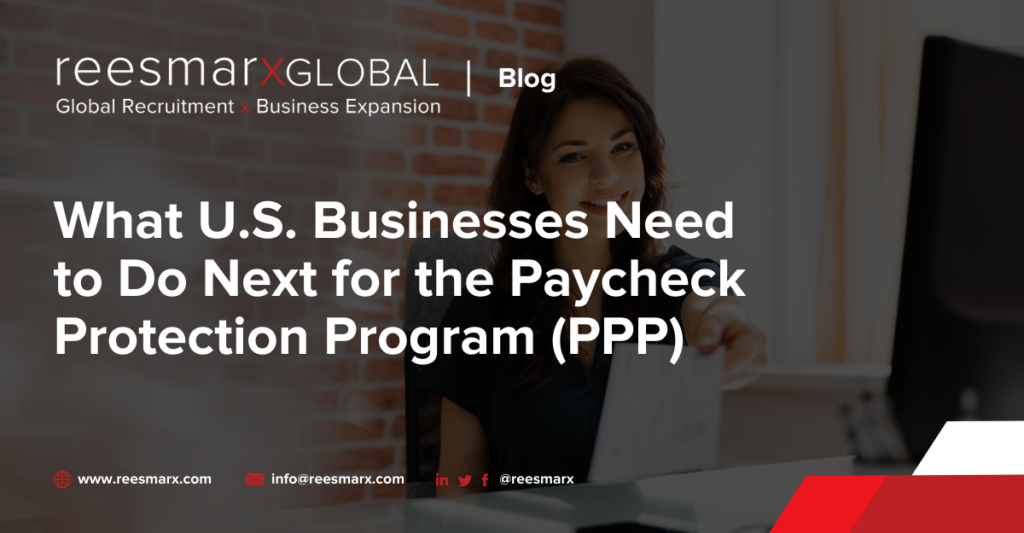On April 3, 2020, the United States Small Business Administration (SBA) made Paycheck Protection Program (PPP) loans available. The CARES Act (Coronavirus Aid, Relief, and Economic Security Act) part of the pandemic stimulus fund and support, allowed for businesses to receive loans. Many of which will be forgivable if businesses met specific terms of the agreement.
In total, more than 5 million PPP loans were approved for American businesses. The last date that a business could apply for a loan was August 8, 2020. In total, the SBA administered $525 billion dollars in support loans.
Many business owners are wondering “what is next?’ in terms of repaying the PPP loan, or applying for the loan forgiveness. There are many questions that business owners who received funds are asking right now, as they wrap up the last quarter, and start organizing tax deductions.
Before your business heads to the SBA Portal to apply for loan forgiveness or set up repayment plans, here are some frequently asked questions and information you should know. There may be some advantages to filing for loan forgiveness before the end of 2020. Or as soon as possible.
1. Are Paycheck Protection Program (PPP) Loans Tax Deductible?
On November 18, 2020, the Internal Revenue Service (IRS) released guidance that would clarify how PPP loans would be classified for business taxes. Accounting and finance experts were advising businesses to wait until this guidance was shared by the IRS.
If a PPP loan was not forgiven by the end of 2020, and the business had expected it to be discharged, the business will be able to deduct those expenses. This will follow the same taxation model as any other kind of loan that is acquired by the business. And if a repayment plan has been created, the loan can be amortized with interest expensed over the period of the repayment schedule.
What happens when businesses do successfully apply for and receive PPP loan forgiveness? Since businesses were not taxed on the proceeds of a forgiven PPP loan, the expenses are not tax deductible for 2020. Since the business owner (taxpayer) has not paid anything out of pocket, it is a net zero sum. The PPP loans are neither a detriment, or a tax benefit to the business.
2. What Does it Take to Prove Eligibility for PPP Loan Forgiveness?
Businesses must prove that the amount of PPP funding they received through the CARES Act was allocated to payroll. The initiative was to help businesses sustain operations, and to help keep more Americans employed during the COVID-19 health emergency.
Business owners must demonstrate that a minimum of 60% of the funds were allocated to the Paycheck Protection Program. That the funds were used to pay employees. Or in some cases, to hire new employees during the pandemic.
“Borrowers are eligible for loan forgiveness for the following costs: 1. Eligible payroll costs. Borrowers are generally eligible for forgiveness for the payroll costs paid and payroll costs incurred during the 24-week (168-day) or 8-week (56-day) Covered Period (or Alternative Payroll Covered Period) (“payroll costs”). Payroll costs are considered paid on the day that paychecks are distributed, or the Borrower originates an ACH credit transaction. Payroll costs are considered incurred on the day that the employee’s pay is earned. Payroll costs incurred but not paid during the Borrower’s last pay period of the Covered Period (or Alternative Payroll Covered Period) are eligible for forgiveness if paid on or before the next regular payroll date. Otherwise, payroll costs must be paid during the Covered Period (or Alternative Payroll Covered Period).
For each individual employee, the total amount of cash compensation eligible for forgiveness may not exceed an annual salary of $100,000, as prorated for the Covered Period. Count payroll costs that were both paid and incurred only once. For information on what qualifies as payroll costs, see Interim Final Rule on Paycheck Protection Program posted on April 2, 2020 (85 FR 20811) (as amended by the Revisions to First Interim Final Rule, posted on June 11, 2020). Include only payroll costs for employees whose principal place of residence is in the United States.”
3. How Do You Apply for PPP Loan Forgiveness?
The Small Business Administration (SBA) provides a portal, and a .PDF downloadable application form for PPP loan forgiveness. This form was updated and is effective as of November 30, 2020 (Version 4).
The application for loan forgiveness contains four sections:
a) The PPP Loan Forgiveness Calculation Form
b) The PPP Schedule A Form
c) The PPP Schedule A Worksheet
d) The PPP Borrower Demographic Information Form (optional)
Both forms a) and b) must be submitted to the lender. For individuals who are self-employed and have no employees, Form 3508EZ can be used. It is a more simplified version of Form 3508 as an application for Paycheck Protection Program (PPP) loan forgiveness.
What Changed Under the PPP Flexibility Act? More Benefits for Small Business Owners
The PPP Flexibility Act was the second part of the legislation, or an amendment to the PPP and Health Care Enhancement Act. It extended many of the rules to benefit not just corporations and large businesses, but small business owners and the self-employed.
· Eligible expenses were changed from 75% payroll and 25% mortgage interest, utilities, or rent to 60% payroll and 40% mortgage interest, utilities or rent.
· The covered period was extended from 8 to 12 weeks.
· FTE Reduction Exemption originally required businesses were “eligible if you could not rehire individuals who were former employees”. That was modified to “eligible if you could not rehire individuals who were former employees or hire similarly qualified employees for empty positions”. Or qualification if the business was able to show that compliance to pandemic health guidelines prevented the business from operating at an efficiency or profitability level consistent with pre-pandemic revenues”.
· Loan term repayment term was extended from two (2) years to five (5) years.
· Employers could originally only defer employee social security payments until they received PPP funding. However, the amendment allowed employers to defer social security tax payments for the duration of 2020.
· The PPP loan deferral period was also extended from six (6) months to the date the SBA remits the PPP loan amount OR ten (10) months after the covered period if the business does not apply for loan forgiveness.
Deferral of social security taxes are only possible for businesses who did not have their PPP loan forgiven in the original draft of the CARES Act. However, the amendment created a universal benefit for all employers (with or without PPP loan forgiveness).
Businesses will be required to repay social security taxes by two deadlines:
a) 50% of social security taxes are due by December 31, 2021.
b) The remaining balance of tax payment is due by December 31, 2022.
The repayment terms are very attractive for business owners. Again, the PPP was meant to be a stimulus to help American businesses weather the pandemic with support from the federal government.Firms can expect to pay an interest rate of 1% and have a six-month grace period before making repayments. Loans that were issued before June 5th must be repaid within two years. However, PPP loans that were issued after that date can be repaid in five years.






